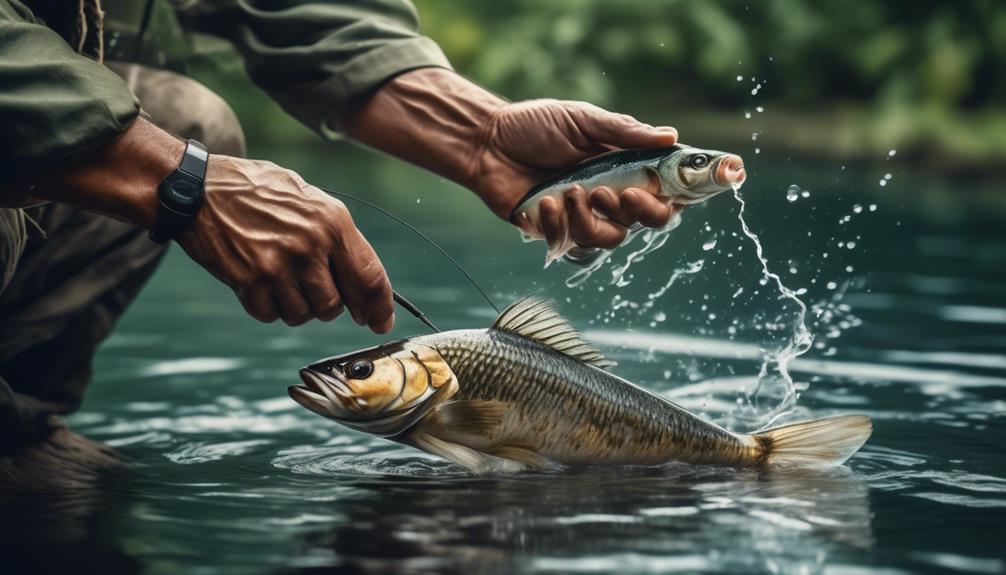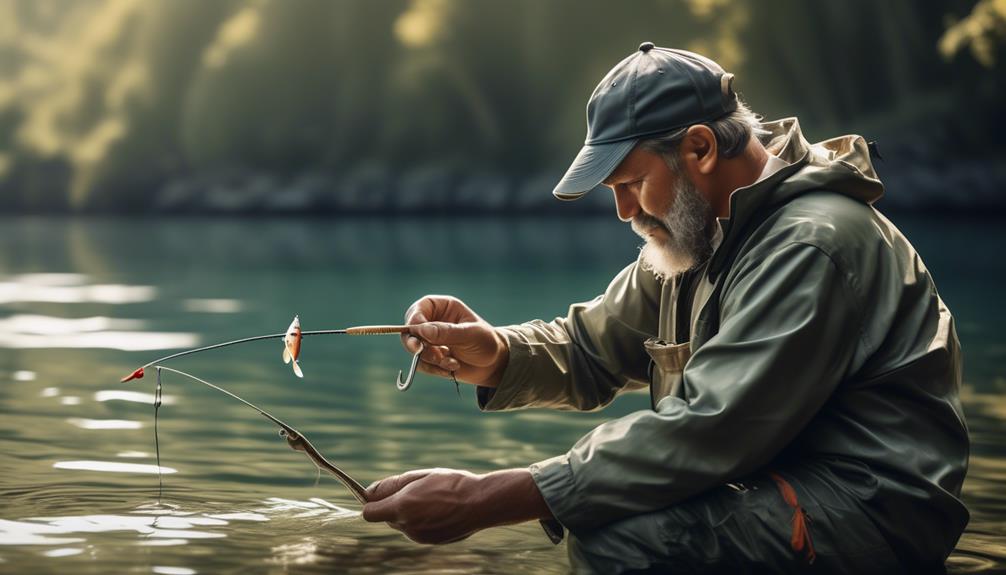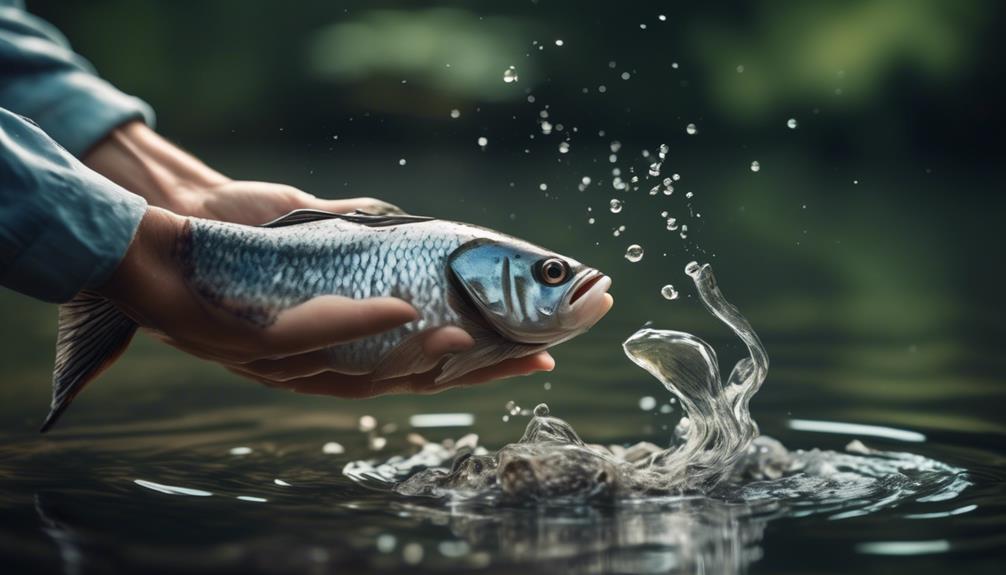Imagine yourself standing knee-deep in a crystal-clear river, the morning sun casting a golden glow on the water's surface. You feel the tug on your line and deftly reel in a beautiful trout, its colors shimmering in the light.
Now, what comes next is crucial. As an angler, you want to ensure that your catch and release practices are ethical and mindful of the well-being of the fish. But what exactly defines ethical practices in catch and release?
It's not just about releasing the fish back into the water; it's about understanding the impact of your actions and the best ways to minimize harm while promoting sustainable fisheries.
Importance of Proper Handling
Proper handling is crucial for the well-being and survival of the fish after being caught and released. When you catch a fish with the intention of releasing it, it's important to handle it with care to ensure its welfare. The way you handle the fish can significantly impact its chances of survival after being released back into the water.
Firstly, when you catch a fish, make sure to handle it as little as possible and to do so with wet hands. This helps to protect the fish's delicate skin and scales, which can be easily damaged when handled with dry hands. Additionally, avoid using a towel or any rough surface to handle the fish as it can remove its protective mucus layer, leaving it vulnerable to infections and diseases.
Secondly, if you need to unhook the fish, do so quickly and efficiently. Use appropriate tools such as needle-nose pliers to minimize the time the fish spends out of the water. The longer the fish is out of the water, the more stressed it becomes, which can have negative effects on its health and survival.
Lastly, when releasing the fish, support it in the water until it's able to swim away on its own. This may take some time, but ensuring that the fish has fully recovered before letting it go increases its chances of survival.
Use of Barbed Vs. Barbless Hooks
When fishing with the intention of catch and release, consider using barbless hooks to minimize harm to the fish. The type of hook you use plays a crucial role in the ethical aspect of catch and release practices.
Barbless hooks are designed to make it easier to remove from the fish, reducing the risk of causing unnecessary harm. When a barbed hook is used, it can cause more extensive damage to the fish's mouth, making it harder for them to feed and increasing their likelihood of succumbing to their injuries after release. By opting for barbless hooks, you're actively promoting ethical catch and release practices.
Using barbless hooks not only benefits the fish but also simplifies the hook removal process for you, the angler. It minimizes the time the fish spends out of the water, which is crucial for their survival post-release. Additionally, barbless hooks can often penetrate and set more firmly in the fish's mouth, reducing the risk of them shaking the hook loose during the fight and potentially injuring themselves further.
Understanding Fish Behavior
With your use of barbless hooks, you can now better understand fish behavior to enhance your catch and release practices. Understanding fish behavior is crucial for successful catch and release. By comprehending how fish feed and avoid predators, you can improve your angling techniques and minimize stress on the fish during the release process.
Fish feeding behavior is influenced by various factors such as water temperature, time of day, and available food sources. Observing the types of prey fish are targeting can provide insight into their feeding patterns. For instance, if you notice fish targeting surface insects, it may indicate that they're feeding near the water's surface. This knowledge can help you adjust your bait presentation to mimic the natural food sources, increasing the likelihood of a successful catch.
Additionally, understanding predator avoidance behavior is essential for ethical catch and release. Fish have evolved various tactics to evade predators, such as seeking shelter in underwater structures or swiftly changing direction when sensing danger. When practicing catch and release, being mindful of these behaviors can help minimize the fish's stress levels. For example, if you observe fish congregating near submerged vegetation for shelter, you can avoid casting in those areas to prevent unnecessary disturbance.
Impact of Water Temperature
Understanding the impact of water temperature on fish behavior is crucial for improving your catch and release practices. Water temperature plays a significant role in the well-being of fish and their ability to handle the stress of being caught and released. Fish are cold-blooded creatures, meaning their internal body temperature is dependent on the temperature of the water around them. When the water is too warm, fish may struggle with temperature regulation, making them more susceptible to stress and less likely to survive after being released.
On the other hand, in colder water, fish may have a reduced metabolism, making it harder for them to recover after being caught.
When engaging in catch and release, it's important to consider the environmental impact of water temperature on fish. High water temperatures can decrease the amount of oxygen in the water, which is essential for the survival of fish. In warmer water, fish may have to work harder to get enough oxygen, further adding to their stress when caught. Additionally, extreme temperature changes, such as rapidly moving a fish from cold water to warm air, can also be harmful. Therefore, being mindful of water temperature and its impact on fish is essential for ethical catch and release practices.
Appropriate Tackle and Gear
Using the right tackle and gear is essential for effective and humane catch and release. Gear selection plays a crucial role in conservation efforts and the overall well-being of the fish population. When choosing your tackle, it's important to consider its environmental impact.
Opt for gear that minimizes harm to the fish and their habitat, such as barbless hooks that reduce injury and make hook removal easier. Additionally, selecting tackle made from sustainable materials supports conservation by reducing the environmental footprint of fishing activities.
When it comes to gear selection, prioritize items that are designed to minimize harm to the fish. For example, using circle hooks instead of J-hooks can significantly reduce the risk of deep hooking, which often leads to internal injuries and decreased survival rates for released fish.
Techniques for Minimizing Harm
Choosing the right techniques for minimizing harm is crucial in ensuring the well-being of the fish population and their ecosystems. By employing these methods, you can significantly reduce stress on the fish and increase their chances of survival after being released back into the water.
Here are three key techniques for minimizing harm:
- Proper Handling: When handling the fish, make sure to wet your hands before touching them. This helps protect their slime layer, which is essential for their protection against infections and parasites. Avoid squeezing the fish or touching their gills, as these actions can cause significant harm and stress.
- Quick Release: Minimizing the time that the fish is out of the water is crucial for their welfare. Keep the fish in the water as much as possible, and if you need to take a photo, have everything ready beforehand to ensure a swift process. The longer the fish is out of the water, the higher the risk of stress and injury.
- Barbless Hooks: Using barbless hooks can make a significant difference in reducing harm to the fish. They're easier to remove, causing less damage to the fish's mouth and reducing the time needed for hook removal. This can greatly decrease stress and injury, improving the fish's chances of survival after release.
Role of Proper Release

Minimizing stress on the fish and ensuring their safe return to the water is paramount in the ethical practice of catch and release. When it comes to the role of proper release, employing appropriate release techniques is crucial in safeguarding fish health and optimizing their chances of survival. Gentle handling and swift release are key components in minimizing the negative impacts of catch and release on fish populations. Properly removing the hook, supporting the fish in an upright position in the water, and waiting for signs of regained strength before releasing it are all essential release techniques.
The role of proper release extends beyond individual fish health to encompass broader environmental impact and survival rates of fish populations. Using barbless hooks, which can be easily removed without causing extensive damage, is a simple yet effective release technique that contributes to the overall well-being of fish. Additionally, avoiding over-handling and keeping the fish in the water as much as possible can help reduce stress and improve their survival rates post-release.
Incorporating these release techniques into your catch and release practices not only promotes ethical angling but also plays a significant role in the conservation of fish populations. By prioritizing the well-being of the fish and considering the broader environmental impact, you can contribute to the sustainability of fisheries for future generations.
Considerations for Sustainable Fisheries
To ensure sustainable fisheries, it's crucial to consider the impact of fishing practices on the overall health and abundance of fish populations. Conservation efforts and responsible angling play a pivotal role in maintaining the delicate balance of aquatic ecosystems and preserving fish populations for future generations. Here are three key considerations for sustainable fisheries:
- Conservation Efforts: Engaging in responsible angling involves adhering to catch and release best practices, such as using barbless hooks, minimizing fight time, and handling fish with care. Additionally, supporting and participating in conservation initiatives, such as habitat restoration projects and fish stocking programs, can contribute to the overall health and resilience of fish populations in various water bodies.
- Ecosystem Impact: Understanding the interconnectedness of aquatic ecosystems and the impact of fishing activities on non-target species, habitats, and water quality is essential. By minimizing the disruption to natural habitats and considering the broader ecosystem impact of fishing practices, anglers can help maintain the ecological balance necessary for sustainable fish populations.
- Fish Population Dynamics: Being mindful of fish population dynamics, including factors such as reproduction rates, growth rates, and natural mortality, is crucial for sustainable fisheries management. Adhering to catch limits, practicing selective harvest, and staying informed about local fishery regulations can aid in preserving fish populations at healthy and sustainable levels.
Frequently Asked Questions
How Does Catch and Release Fishing Impact the Overall Fish Population in a Body of Water?
When you practice catch and release, you help maintain fish population dynamics and support fish conservation. By releasing fish, you reduce fishing pressure, allowing the population to thrive.
This contributes to the overall health of the ecosystem. By carefully handling and releasing fish, you play a crucial role in sustaining the fish population and preserving the balance of the aquatic environment.
Are There Any Specific Regulations or Guidelines for Catch and Release Fishing in Different Regions?
In different regions, specific regulations and guidelines exist to ensure ethical catch and release fishing practices. These rules aim to minimize the environmental impact and preserve fish populations. Conservation efforts are supported through these regulations, which dictate proper handling and release techniques. By following these guidelines, anglers contribute to sustainable fishing practices and the long-term health of aquatic ecosystems.
Always be mindful of the regulations in your area to promote responsible and ethical catch and release fishing.
What Are the Potential Long-Term Effects on a Fish That Has Been Caught and Released Multiple Times?
Catch and release fishing can cause fish stress, affecting their survival.
When a fish is caught and released multiple times, it experiences increased stress levels, which can impact its long-term health and survival.
Continuous handling and hooking can lead to physical harm and decreased reproductive success.
To minimize these impacts, proper handling techniques and appropriate gear can help reduce fish stress and increase the chances of survival after being caught and released.
How Can Anglers Ensure That They Are Using the Most Ethical and Sustainable Fishing Practices in General, Beyond Just Catch and Release?
To ensure you're using the most ethical and sustainable fishing practices, consider sustainable practices like:
- Using barbless hooks
- Minimizing the use of live bait
- Releasing undersized fish
Support conservation efforts by:
- Not overfishing
- Following catch limits
Respect protected areas and wildlife by:
- Properly disposing of fishing line and gear
Participate in habitat restoration projects to:
- Contribute to the long-term health of fish populations and their ecosystems.
What Are the Ethical Considerations When It Comes to Using Live Bait Versus Artificial Lures in Catch and Release Fishing?
When it comes to catch and release fishing, using live bait can have an environmental impact, potentially disrupting ecosystems. Artificial lures, on the other hand, minimize harm to fish populations and their dynamics.
Consider the ethical considerations of the methods you use, and opt for artificial lures to reduce harm to the environment and fish populations. By making this choice, you can contribute to sustainable and ethical catch and release practices.
Conclusion
In conclusion, ethical practices in catch and release fishing are crucial for the well-being of fish populations and the sustainability of fisheries.
Proper handling, understanding fish behavior, and using appropriate gear are all essential components of ethical catch and release.
By minimizing harm and ensuring proper release, anglers can contribute to the conservation of fish populations and the overall health of aquatic ecosystems.
It's important to consider these ethical practices for the future of fishing and the environment.



